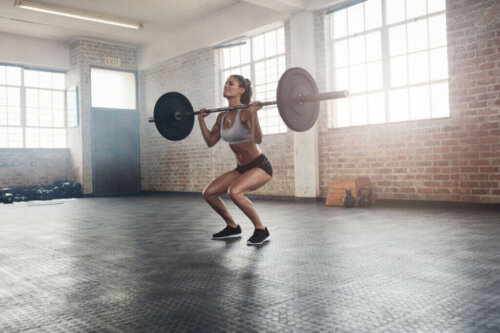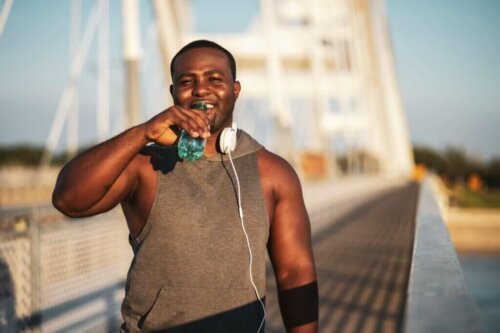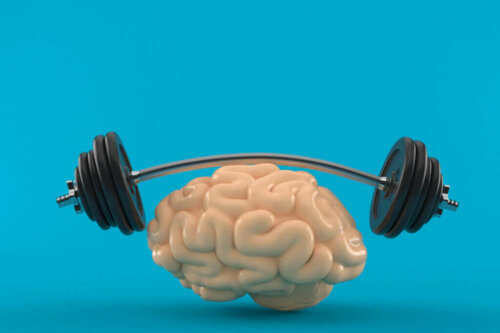4 Exercises to Increase Flexibility

Each person’s basic physical abilities are mostly determined by their own genetics. These abilities influence your motor control and allow you to carry out your daily tasks and activities. However, each of these abilities can also be worked on and improved. For example, it’s possible to increase your flexibility by doing certain exercises.
In this article, we’ll be focusing on flexibility, specifically, for a number of reasons. One such reason is that flexibility is one of the physical abilities that begins to diminish at an early age, as opposed to strength or resistance. However, it’s very possible to work on your flexibility and increase it even after 18 years years of age. Here, we’ll give you some tips on ways that you can work on this ability and increase it.
A routine to increase flexibility
Flexibility is a human ability that’s completely linked to the joints and muscle groups. Without our joints, no part of the body would be able to move at all.
Flexibility works in connection with our joint mobility and muscular elongation. These are the two traits that favor the physical ability to flex any part of the body. In addition, despite the fact that these traits involve involuntary characteristics, there are aspects that you can work on throughout your entire life.
To increase your flexibility, there are different methods of training and exercise that you can do. Here, we’ll present a list of some of the best methods for you to practice.
1. Stretching the anterior zone of the muscle
The anterior part of your legs are made up of the quadriceps, frequently referred to as “quads,” which are one of the largest muscle groups in the human body. The ability to stretch these muscles is a crucial way to increase your flexibility.
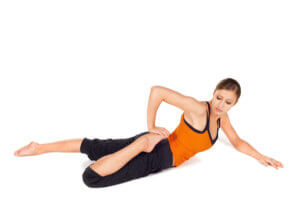
One good way to stretch these muscles is by laying down on the floor face down and flexing the leg muscle that you’re going to stretch without lifting it off the floor. Then, place the food of the flexed leg into your hand and bring it towards your glute on the same side. Hold this stretch for at least 20 seconds. Once finished, slowly lower the foot back to the ground and repeat on your other leg for the same amount of time.
2. Increase flexibility: stretch the posterior zone of the muscle
In order to truly increase your flexibility in certain areas of the body, you have to make sure that both sides are equally exercised. Therefore, if you stretch the anterior portion of a muscle, you have to make sure that you are stretching the posterior side of the muscle as well.
In order to stretch the posterior side of your legs, begin seated on the floor. Stretch both legs out in front of you, while being slightly separated. From there, reach with each hand and touch the tip of the toes of the foot that corresponds. Hold this position for at least 20 seconds.
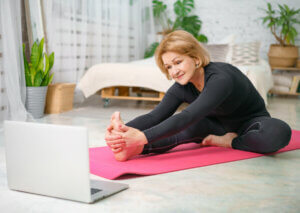
Another great way to stretch the muscles on the posterior side of the legs and your abductors is through a similar position to the last one. In this iteration, stretch out only one leg while the other remains relaxed. Then, reach with the hand that corresponds to the active leg and hold the stretch for at least 20 seconds.
3. Work your lower back
When thinking about stretching and flexibility, you can’t forget about the importance of a healthy back. The lumbar region is one of the areas of the body that suffers the most from a sedentary lifestyle. However, it can also suffer from excessive physical exercise. This can occur when you are out of shape and it can be improved with flexibility.
To increase and improve this area of your body, you need to ensure that you are regularly stretching this zone. This can be done by a simple face-up position, as we’ll tell you below.
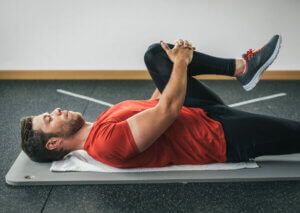
Once you’re lying down with your face up, bring one leg towards your trunk. Then, place both hands around your knee and use your strength to bring the knee towards your chest. Hold this stretch for at least 20 seconds. Once finished, slowly lower the leg back down to the ground. Continue with the same movement on the other side.
4. Stretching your trunk
In addition to the legs and back, which are both parts of the body that we’ve previously mentioned, it’s also important to increase your flexibility in the muscles of the trunk. For this, there’s an easy, common exercise that can bring great results. This exercise is commonly called the “bridge” pose and is regularly employed in yoga practices.

To begin this position, lie on the ground with your face up. From there, ensure that the soles of both feet are planted securely on the ground in front of you. Once your feet are securely planted, position your arms by your sides in order to support yourself. From there, slowly lift your hips into the air and sustain them. This position allows a deep stretch of all of the muscles of the back, as well as the neck and shoulders.
The importance of increasing flexibility
Stretching isn’t only important to do after an exercise session or a workout, it’s important to include it in your regular routine. A complete training routine should take into account increasing flexibility.
In addition, it’s always recommended to improve your diet and consume products that are nutrient-dense. This will also aid this ability in the body. To learn more about diet improvements that can aid in flexibility, we recommend seeing a qualified nutritionist who can help you to make a plan.
Finally, remember that any stretch is going to depend on your own physical abilities. Everybody is different. Progress happens slowly, and it’s better to not force yourself to do any movement before your body is ready. This can help you to avoid injury.
Each person’s basic physical abilities are mostly determined by their own genetics. These abilities influence your motor control and allow you to carry out your daily tasks and activities. However, each of these abilities can also be worked on and improved. For example, it’s possible to increase your flexibility by doing certain exercises.
In this article, we’ll be focusing on flexibility, specifically, for a number of reasons. One such reason is that flexibility is one of the physical abilities that begins to diminish at an early age, as opposed to strength or resistance. However, it’s very possible to work on your flexibility and increase it even after 18 years years of age. Here, we’ll give you some tips on ways that you can work on this ability and increase it.
A routine to increase flexibility
Flexibility is a human ability that’s completely linked to the joints and muscle groups. Without our joints, no part of the body would be able to move at all.
Flexibility works in connection with our joint mobility and muscular elongation. These are the two traits that favor the physical ability to flex any part of the body. In addition, despite the fact that these traits involve involuntary characteristics, there are aspects that you can work on throughout your entire life.
To increase your flexibility, there are different methods of training and exercise that you can do. Here, we’ll present a list of some of the best methods for you to practice.
1. Stretching the anterior zone of the muscle
The anterior part of your legs are made up of the quadriceps, frequently referred to as “quads,” which are one of the largest muscle groups in the human body. The ability to stretch these muscles is a crucial way to increase your flexibility.

One good way to stretch these muscles is by laying down on the floor face down and flexing the leg muscle that you’re going to stretch without lifting it off the floor. Then, place the food of the flexed leg into your hand and bring it towards your glute on the same side. Hold this stretch for at least 20 seconds. Once finished, slowly lower the foot back to the ground and repeat on your other leg for the same amount of time.
2. Increase flexibility: stretch the posterior zone of the muscle
In order to truly increase your flexibility in certain areas of the body, you have to make sure that both sides are equally exercised. Therefore, if you stretch the anterior portion of a muscle, you have to make sure that you are stretching the posterior side of the muscle as well.
In order to stretch the posterior side of your legs, begin seated on the floor. Stretch both legs out in front of you, while being slightly separated. From there, reach with each hand and touch the tip of the toes of the foot that corresponds. Hold this position for at least 20 seconds.

Another great way to stretch the muscles on the posterior side of the legs and your abductors is through a similar position to the last one. In this iteration, stretch out only one leg while the other remains relaxed. Then, reach with the hand that corresponds to the active leg and hold the stretch for at least 20 seconds.
3. Work your lower back
When thinking about stretching and flexibility, you can’t forget about the importance of a healthy back. The lumbar region is one of the areas of the body that suffers the most from a sedentary lifestyle. However, it can also suffer from excessive physical exercise. This can occur when you are out of shape and it can be improved with flexibility.
To increase and improve this area of your body, you need to ensure that you are regularly stretching this zone. This can be done by a simple face-up position, as we’ll tell you below.

Once you’re lying down with your face up, bring one leg towards your trunk. Then, place both hands around your knee and use your strength to bring the knee towards your chest. Hold this stretch for at least 20 seconds. Once finished, slowly lower the leg back down to the ground. Continue with the same movement on the other side.
4. Stretching your trunk
In addition to the legs and back, which are both parts of the body that we’ve previously mentioned, it’s also important to increase your flexibility in the muscles of the trunk. For this, there’s an easy, common exercise that can bring great results. This exercise is commonly called the “bridge” pose and is regularly employed in yoga practices.

To begin this position, lie on the ground with your face up. From there, ensure that the soles of both feet are planted securely on the ground in front of you. Once your feet are securely planted, position your arms by your sides in order to support yourself. From there, slowly lift your hips into the air and sustain them. This position allows a deep stretch of all of the muscles of the back, as well as the neck and shoulders.
The importance of increasing flexibility
Stretching isn’t only important to do after an exercise session or a workout, it’s important to include it in your regular routine. A complete training routine should take into account increasing flexibility.
In addition, it’s always recommended to improve your diet and consume products that are nutrient-dense. This will also aid this ability in the body. To learn more about diet improvements that can aid in flexibility, we recommend seeing a qualified nutritionist who can help you to make a plan.
Finally, remember that any stretch is going to depend on your own physical abilities. Everybody is different. Progress happens slowly, and it’s better to not force yourself to do any movement before your body is ready. This can help you to avoid injury.
All cited sources were thoroughly reviewed by our team to ensure their quality, reliability, currency, and validity. The bibliography of this article was considered reliable and of academic or scientific accuracy.
- De Haan, J., & Friesen, P. K. (2016). Flexibilidad. In Journal of Christian nursing : a quarterly publication of Nurses Christian Fellowship. https://doi.org/10.1097/cnj.0000000000000263
- Blum, B. (1998). Los estiramientos. In MéTodos Actuales De Stretching. Desarrollan La Flexibilidad Y Elasticidad. Mejoran La Salud Y El Rendimiento. Alivian Los Dolores Articulares Y Evitan Las Lesiones.
This text is provided for informational purposes only and does not replace consultation with a professional. If in doubt, consult your specialist.



